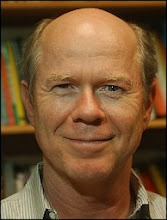I found this article in the San Jose Mercury News dated June 12, 2008 by Amber Dance
Ryan Withers had so much fun at his therapist's office that his older brother got jealous. Robert wanted to play the video games, too. The 12-year-old Ryan was having trouble paying attention to the home-school tasks his mother, Cindy Withers of San Jose, set for him. Determined to avoid drugs such as Ritalin, Withers opted for brain-training instead.
At his psychologist's office, Ryan's treatment included specialized video games that responded to his brain waves. By remaining focused, the boy was able to propel digital spaceships or race cars. His mother says the therapy gave him a "can-do" attitude and improved his school work. That therapy - neurofeedback - is a growing, though controversial, field. Advocates claim it treats everything from pre-menstrual syndrome to teeth grinding. Attention deficit hyperactivity disorder, which affects as many as one in 10 boys, is a popular target.
Neurofeedback is an appealing alternative for parents who fear medication will turn their children into pill-popping zombies. It also attracts athletes, like professional basketball player Chris Kaman of the Los Angeles Clippers, who says neurofeedback improved his play. However, mainstream medicine remains skeptical. "Most of the people who come to me don't want their doctors to know," said Ryan's psychologist, Mark Steinberg of Los Gatos. Critics say neurofeedback research isn't up to medicine's exacting standards. Most psychologists think the tried-and-true medications should be the first treatment.
But Steinberg, who co-wrote a book about brain training and ADHD, says the treatment works for 80 percent of patients with ADHD. Although drugs like Ritalin have a similar success rate, in some patients they cause side effects including weight loss and insomnia, said psychologist Alfred Scopp of Mountain View. In the 1960s and '70s, brain training appealed to parapsychologists and drug experimenters - and that hippie-dippy image has been hard to shed. Scientists back then lacked a detailed understanding of brain activity.
Now, researchers at the University of California-Berkeley read minds with brain scans. In Pittsburgh, Pa., monkeys learn to control a mechanical arm with their minds, reaching for snacks without lifting their own fingers. In light of modern advances, brain training doesn't seem so wacky. "We'll be noticed very shortly," said Siegfried Othmer, chief scientist at the EEG Institute in Woodland Hills. "We're going to be a significant factor in mental health." Neurofeedback proponents say the root of many disorders is an imbalance in brain waves. When brain cells work together, they produce an electrical signal, or wave. The waves drift slowly during sleep or relaxation. They speed up when the brain is awake. Kids with ADHD are often stuck on slower waves.
In neurofeedback, good things happen when the brain makes the right signals. The reward is success in a video game that responds to brain waves instead of a joystick. Scalp electrodes link the brain to the program. In one game, the desired brain signals propel a spaceship. The wrong brain waves call up an ominous shadow in the passageway ahead. For the patient, it's an amusing game. For the brain, it's like a mirror on its own activity. Through instant feedback, the program subtly encourages the brain to make the right signals. Some call the games' rewards "electronic M&Ms."
The theory is that the brain will remember its new skill, and the kids will make those waves the next time they need to pay attention. Different program settings encourage fast or slow brain waves, depending on the patient's needs. For ADHD, studies show neurofeedback works as well as Ritalin, and the effects last longer. Other experiments support its use for epilepsy, anxiety and insomnia. The claims that it can treat conditions like Lyme disease or bulimia are on shakier ground.
"I'm skeptical of 'one size fits all,' " said Dr. Glen Elliott, chief psychiatrist at the Children's Health Council in Palo Alto. Cost can also be a factor. A therapist might recommend 40 or more sessions, at $50 to $150 each. Many insurance plans won't pay. Fans are happy to pull out their checkbooks. Some seek neurofeedback even though they're mentally healthy. Athletes use it to get into "the zone." The elderly may get a boost in brain function. Silicon Valley executives hope to extract the maximum power from their minds.
"Maybe the Dalai Lama's the only person I know that might not need neurofeedback," said Cynthia Kerson, director of the International Society for Neurofeedback and Research in San Rafael.

